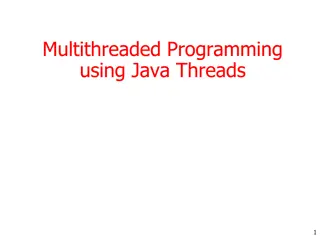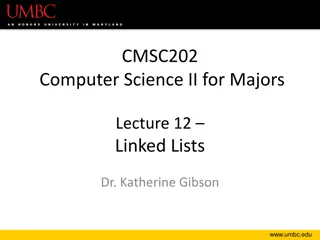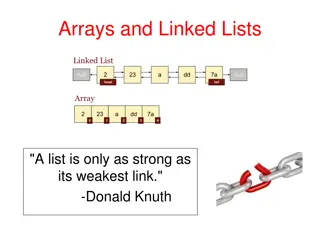Understanding Threads, Linked Lists, and Programming Models in Concurrent Programs
Delve into the concepts of threads, linked lists, and programming models in concurrent programs. Explore the use of threads for handling multiple requests, the struct types in programming, and the various access methods for lists. Learn about the benefits of threads and how they enable parallel processing for efficient program execution.
Download Presentation

Please find below an Image/Link to download the presentation.
The content on the website is provided AS IS for your information and personal use only. It may not be sold, licensed, or shared on other websites without obtaining consent from the author. Download presentation by click this link. If you encounter any issues during the download, it is possible that the publisher has removed the file from their server.
E N D
Presentation Transcript
structs and memory layout fox fox fox list.next list.prev list.next list.prev list.next list.prev
Linked lists in Linux Node; fox fox fox list { .next .prev } list { .next .prev } list { .next .prev }
What about types? Calculates a pointer to the containing struct struct list_head fox_list; struct fox * fox_ptr = list_entry(fox_list->next, struct fox, node);
List access methods struct list_head some_list; list_add(struct list_head * new_entry, struct list_head * list); list_del(struct list_head * entry_to_remove); struct type * ptr; list_for_each_entry(ptr, &some_list, node){ } struct type * ptr, * tmp_ptr; list_for_each_entry_safe(ptr, tmp_ptr, &some_list, node) { list_del(ptr); kfree(ptr); }
Why use threads Web servers can handle multiple requests concurrently Web browsers can initiate multiple requests concurrently Parallel programs running on a multiprocessor concurrently employ multiple processors Multiplying a large matrix split the output matrix into k regions and compute the entries in each region concurrently using k processors
Programming models Concurrent programs tend to be structured using common models: Manager/worker Single manager handles input and assigns work to the worker threads Producer/consumer Multiple producer threads create data (or work) that is handled by one of the multiple consumer threads Pipeline Task is divided into series of subtasks, each of which is handled in series by a different thread
Needed environment Concurrent programs are generally tightly coupled Everybody wants to run the same code Everybody wants to access the same data Everybody has the same privileges Everybody uses the same resources (open files, network connections, etc.) But they need multiple hardware execution states Stack and stack pointer (RSP) Defines current execution context (function call stack) Program counter (RIP), indicating the next instruction Set of general-purpose processor registers and their values
Supporting Concurrency Key idea separate the concept of a process (address space, etc.) from that of a minimal thread of control (execution state: PC, etc.) creating concurrency does not require creating new processes This execution state is usually called a thread, or sometimes, a lightweight process
Address Spaces VDSO kernel virtual memory kernel physical memory stack Memory mapped devices Memory mapped region for shared libraries run-time heap (via malloc) run-time heap (via malloc) run-time heap (via malloc) uninitialized data (.bss) initialized data (.data) program text (.text) 0
Threads and processes Most modern OS s (Mach, Chorus, Windows XP, modern Unix (not Linux)) therefore support two entities: process: defines the address space and general process attributes (such as open files, etc.) Thread: defines a sequential execution stream within a process A thread is bound to a single process But processes can have multiple threads executing within them Sharing data between threads is easy: same address space Threads become the unit of scheduling Processes are just containers in which threads execute
Execution States Threads also have execution states
Types of threads User Threads vs Kernel Threads
Kernel threads OS now manages threads and processes All thread operations are implemented in the kernel OS schedules all of the threads in a system if one thread in a process blocks (e.g., on I/O), the OS knows about it, and can run other threads from that process possible to overlap I/O and computation inside a process Kernel threads are cheaper than processes less state to allocate and initialize But, they re still pretty expensive for fine-grained use (e.g., orders of magnitude more expensive than a procedure call) Thread operations are all system calls context switch argument checks Must maintain kernel state for each thread
Context Switching Like process context switch Trap to kernel Save context of currently running thread Push machine state onto thread stack Restore context of the next thread Pop machine state from next thread s stack Return as the new thread Execution resumes at PC of next thread What s not done? Change address space
User Level Threads To make threads cheap and fast, they need to be implemented at the user level managed entirely by user-level library, e.g. libpthreads.a User-level threads are small and fast each thread is represented simply by a PC, registers, a stack, and a small thread control block (TCB) creating a thread, switching between threads, and synchronizing threads are done via function calls no kernel involvement is necessary! user-level thread operations can be 10-100x faster than kernel threads as a result A user-level thread is managed by a run-time system user-level code that is linked with your program
Context Switching Like process context switch trap to kernel save context of currently running thread push machine state onto thread stack restore context of the next thread pop machine state from next thread s stack return as the new thread execution resumes at PC of next thread What s not done: change address space
ULT implementation A process executes the code in the address space Process: the kernel-controlled executable entity associated with the address space This code includes the thread support library and its associated thread scheduler The thread scheduler determines when a thread runs it uses queues to keep track of what threads are doing: run, ready, wait just like the OS and processes but, implemented at user-level as a library
ULTs Pros and Cons Disadvantages Most system calls are blocking for processes All threads within a process will be implicitly blocked Waste of resource and decreased performance The kernel can only assign processors to processes. Two threads within the same process cannot run simultaneously on two processors Advantages Thread switching does not involve the kernel no need for mode switching Fast context switch time, Threads semantics are defined by application Scheduling can be application specific Best algorithm can be selected ULTs are highly portable Only a thread library is needed
KLT Pros and Cons Advantages The kernel can schedule multiple threads of the same process on multiple processors Blocking at thread level, not process level If a thread blocks, the CPU can be assigned to another thread in the same process Even the kernel routines can be multithreaded Disadvantages Thread switching always involves the kernel This means two mode switches per thread switch are required KTLs switching is slower compared ULTs Still faster than a full process switch
pthread API This is taken from the POSIX pthreads API: t = pthread_create(attributes, start_procedure) creates a new thread of control new thread begins executing at start_procedure pthread_cond_wait(condition_variable) the calling thread blocks, sometimes called thread_block() pthread_signal(condition_variable) starts the thread waiting on the condition variable pthread_exit() terminates the calling thread pthread_join(t) waits for the named thread to terminate
Preemption Strategy 1: Force everyone to cooperate A thread willingly gives up the CPU by calling yield() yield() calls into the scheduler, which context switches to another ready thread What happens if a thread never calls yield()? Strategy 2: Use preemption Scheduler requests that a timer interrupt be delivered by the OS periodically Usually delivered as a UNIX signal (man signal) Signals are just like software interrupts, but delivered to userlevel by the OS instead of delivered to OS by hardware At each timer interrupt, scheduler gains control and context switches as appropriate
Cooperative Threads Cooperative threads use non pre-emptive scheduling Advantages: Simple Scientific apps Disadvantages: For badly written code Scheduler gets invoked only when Yield is called A thread could yield the processor when it blocks for I/O Does this lock the system?
Threads and I/O The kernel thread issuing an I/O request blocks until the request completes Blocked by the kernel scheduler How to address this? One kernel thread for each user level thread common case operations (e.g., synchronization) would be quick Limited-size pool of kernel threads for all the user-level threads The kernel will be scheduling its threads obliviously to what s going on at user-level
Combined ULTs and KLTs Solaris Approach
Combined ULT/KLT Approaches Thread creation done in the user space Bulk of thread scheduling and synchronization done in user space ULT s mapped onto KLT s The programmer may adjust the number of KLTs KLT s may be assigned to processors Combines the best of both approaches Many-to-Many Model
Solaris Process Structure Process includes the user s address space, stack, and process control block User-level threads Threads library Library supports for application parallelism Invisible to the OS Kernel threads Visible to the kernel Represents a unit that can be dispatched on a processor Lightweight processes (LWP) Each LWP supports one or more ULTs and maps to exactly one KLT
Solaris Threads bound thread Task 2 is equivalent to a pure ULT approach Traditional Unix process structure Tasks 1 and 3 map one or more ULT s onto a fixed number of LWP s, which in turn map onto KLT s Note how task 3 maps a single ULT to a single LWP bound to a CPU
Solaris User Level Threads Share the execution environment of the task Same address space, instructions, data, file (any thread opens file, all threads can read). Can be tied to a LWP or multiplexed over multiple LWPs Represented by data structures in address space of the task but kernel knows about them indirectly via LWPs
Solaris Kernel Level Threads Only objects scheduled within the system May be multiplexed on the CPU s or tied to a specific CPU Each LWP is tied to a kernel level thread
Solaris Versatility ULTs can be used when logical parallelism does not need to be supported by hardware parallelism Eliminates mode switching Multiple windows but only one is active at any one time If ULT threads can block then more LWPs can be added to avoid blocking the whole application High Versatility System can operate in a Windows style or conventional Unix style, for example
ULTs, LWPs and KLTs LWP can be viewed as a virtual CPU The kernel schedules the LWP by scheduling the KLT that it is attached to Run-time library (RTL) handles multiple When a thread invokes a system call, the associated LWP makes the actual call LWP blocks, along with all the threads tied to the LWP Any other thread in same task will not block.
Thread Implementation Scheduler Activation
Threads and locking If one thread holds a lock and is scheduled out Other threads will be unable to enter the critical section and will block (stall) Solving this requires coordination between the kernel and the user-level thread manager scheduler activations each process can request one or more kernel threads process is given responsibility for mapping user-level threads onto kernel threads kernel promises to notify user-level before it suspends or destroys kernel thread
Scheduler Activation Motivation Application has knowledge of the user-level thread state but has little knowledge of or influence over critical kernel-level events By design, to achieve the virtual machine abstraction Kernel has inadequate knowledge of user-level thread state to make optimal scheduling decisions Underscores the need for a mechanism that facilitates exchange of information between user-level and kernel-level mechanisms. A general system design problem: communicating information and control across layer boundaries while preserving the inherent advantages of layering, abstraction, and virtualization.
Scheduler Activations: Structure User Change in Processor Requirements . . . Thread Library Scheduler Activation Kernel Support Change in Processor Allocation Change in Thread Status Kernel
Communication via Upcalls The kernel-level scheduler activation mechanism communicates with the user-level thread library by a set of upcalls Add this processor (processor #) Processor has been preempted (preempted activation #, machine state) Scheduler activation has blocked (blocked activation #) Scheduler activation has unblocked (unblocked activation #, machine state) The thread library must maintain the association between a thread s identity and thread s scheduler activation number.
Role of Scheduler Activations Abstraction Implementation . . . . . . User-level Threads Thread Library Kernel . . . . . . P2 SA P1 SA SA Pn Invariant: There is one running scheduler activation (SA) for each processor assigned to the user process. Virtual Multiprocessor
Avoiding Effects of Blocking User User 5: Start 1 1: System Call 4: Upcall 3: New 2: Block 2 kernel Kernel Kernel Threads Scheduler Activations
Resuming Blocked Thread user 5 4 4: preempt 5: resume 3: upcall 2: preempt 1: unblock kernel
Scheduler Activations Summary Threads implemented entirely in user-level libraries Upon calling a blocking system call Kernel makes an up-call to the threads library Upon completing a blocking system call Kernel makes an up-call to the threads library Is this the best possible solution? Why not? Specifically, what popular principle does it appear to violate?
You really want multiple threads per address space Kernel threads are much more efficient than processes, but they re still not cheap all operations require a kernel call and parameter verification User-level threads are: fast as blazes great for common-case operations creation, synchronization, destruction can suffer in uncommon cases due to kernel obliviousness I/O preemption of a lock-holder Scheduler activations are the answer pretty subtle though























